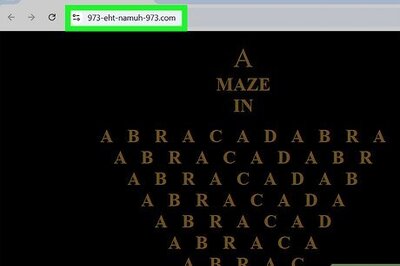
views
At first glance, it is difficult to believe that the heap of weathered and uneven stones can be likened to a turtle, whichever way you look at it. “The aerial view will do it full justice,” smiles Dr Rama Krishna Pisipaty understandingly. “Try imagining how the head and tail of a turtle look and then look at it again,” he urges. Slowly, the idea sinks in and the heap does begin to look like a huge, reptilian turtle.When Dr Pisipaty first got to this hill two years ago, on the banks of the Vadamangalam village lake, it was a mass of overgrown weeds and weathered rocks. “ASI had listed it as a potential heritage site in the late 60s but the locals and miners hadn’t really treated it with any regard till last month,’” he laments. The evidence points to the Early Iron Age, which dates back almost 3,000 years.With a team of research scholars from SCSVMV University, where Pisipaty is a professor and geoarchaeologist, he began the dig on February 15 after scouring the area and marking likely spots. “We couldn’t use crowbars and shovels because the professor said that it could damage the findings inside,” reveals Paneerselvam, a villager who assisted with the excavation. “After we removed the layer of red soil on top, we used small picks and hand brushed the rest out carefully. It was a lot of work,” he sighs, but pride prevails.It paid off - this is the first time in recorded history that a memorial formation shaped like a turtle has been documented, he says. The biggest finding of the five Cairn memorials (rock formation arranged without cement) is obviously the 24-metre long turtle memorial, whose shell is made up of 21 boulders stacked together.“Inside the shell, we found a earthen sarcophagus surrounded with four haematite stones - almost like a Vedic fire altar. Around this there were flat, cut Cudappah stones laid like a platform on the bedrock,” he relates. As there were no human remains found, this must have been more of a memorial than a tomb, he surmises. “In fact no human remains have been found in any of the excavated sites, which makes us believe that this must have been some memorial-ground for the deceased. Rather intriguingly, both the haematite and Cudappah stones are not native to the region. This led Pisipaty to believe that they were brought from a distance to “honour the dead” and shaped with Iron Age chisels and tools.Evidence was found in a smaller memorial, where a chisel and some jars were unearthed. Offering bowls and sarcophagi have been shifted to the University while the stone formations alone remain. This tied in nicely with a metal workshop that he excavated in nearby Palnellur, some years ago. “This was clearly a learned civilization that had knowledge of astronomy and primitive sciences, despite looking and living like some tribal clan,” he figures. All the tombs have been aligned along the North-West axis and are believed to have astronomical significance, he adds.Walking around, there are some deep pits that look like ravines. He shrugs it off with a grimace, “There have been people mining even here for sand and stone. Almost 70 per cent of this site has been destroyed thanks to this, but there is still plenty left,” he brightens up.What if it rains? “The ASI will have to protect this turtle and the other structures, now that they are exposed to the elements,” he states wistfully. “There is lots of studying to be done to date the era and understand the culture, but most of it had broken and decomposed,” he says ruefully.But this will just serve as a push for more excavation to see what else Vadamangalam holds for the diminutive archaeologist.



















Comments
0 comment